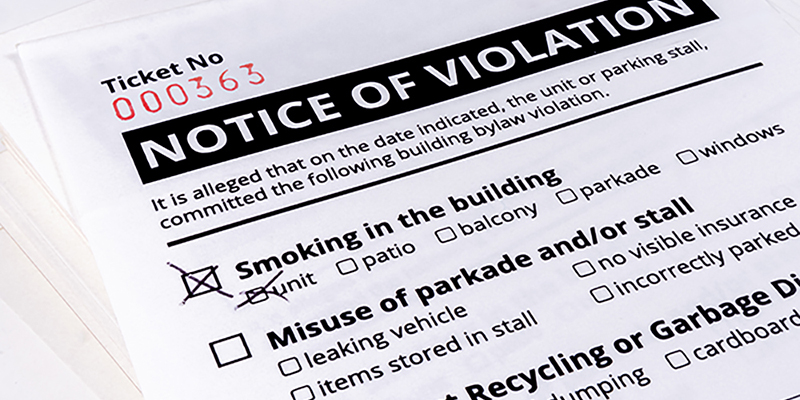
Why Transparency Matters in HOA Financial Management
October 13, 2025
Why HOAs Need a Disaster Recovery Plan
October 17, 2025Living in a managed community comes with an interesting dynamic – homeowners want attractive neighborhoods but often resist being told what to do with their own property. This fundamental tension is exactly what skilled HOA management navigates every day.
In this article, we’ll explore the most common HOA violations that management companies encounter and provide practical advice for strategies to enact that can address them.
The Usual Suspects
The Jungle Next Door
Every community has that house – the one where the grass reaches knee-height and flowerbeds have more weeds than the vacant lot down the street.
There are many reasons for lawn and landscaping neglect. The owners may be traveling, have health issues that prevent them from doing yard work, have broken equipment, or simply be too busy. They may also only live in the unit for part of the year. Whatever the reason, neglected yards are not only unsightly, but they can also decrease property values and pose a fire hazard in dry climates.
The “Ask Forgiveness Not Permission” Crowd
“What do you mean I needed approval for my chartreuse front door?”
The number of homeowners who skip the architectural review process is staggering. From unauthorized sheds appearing overnight to massive deck extensions that somehow weren’t “in the plans,” residents consistently renovate first and read the rules later (if ever).
The frustrating part? Many of these modifications might have been approved with minor adjustments had the homeowner simply filed the paperwork first.
Monument to Garbage Day
Some residents treat their trash cans like prized possessions that deserve front yard display. They roll them out Monday morning and bring them back the following Sunday – if at all. Permanent trash can installations become neighborhood landmarks: “Turn right at the Johnston’s garbage cans, you can’t miss ’em.”
Parking Lot or Driveway?
That commercial work truck with “Bob’s Plumbing” plastered on the side. The 30-foot RV that hasn’t moved since 2019. The collection of “project cars” that somehow never progress past the disassembled stage.
Unauthorized parking is immediately noticeable to both residents and visitors, and it can quickly become a widespread issue. Consistent enforcement is crucial for effective HOA management.
Pet-related violations in your HOA can range from bothersome noise disturbances, such as incessant barking, to unsanitary conditions like pet waste not being picked up, to potentially dangerous situations with aggressive, unleashed animals. These violations are unique in that they are not stationary and can impact the entire neighborhood.
Christmas All Year Long
HOA regulations frequently specify the duration for which seasonal decorations are permitted, to uphold the community’s visual appeal. Regrettably, some homeowners annually disregard these rules, leaving their holiday decorations up far too long. For instance, Christmas lights still adorning houses in April can be a source of annoyance for other residents who adhere to the guidelines and value their neighborhood’s appearance.
Rogue Landlords
“Sure, my lease agreement says six-month minimum, but these vacation renters paid double!” When owners ignore rental restrictions, they’re not just breaking rules – they’re potentially changing the entire character of a neighborhood from stable residences to transient housing.
Handling Violations Without Making Enemies for Life
The Velvet Glove Approach
Nobody appreciates finding a threatening violation notice as their introduction to the HOA. Smart boards start with a friendly touch:
Maybe it’s a casual doorhanger that says, “Hey neighbor! Just a reminder that trash cans should be tucked away by Tuesday evening.” No threats, no citations of bylaws, just a neighborly nudge.
If that doesn’t work, then escalation to something more official becomes necessary. But always with reasonable timeframes – expecting someone to fix peeling house paint in 48 hours is ridiculous, but expecting trash cans to be put away within a day is perfectly reasonable.
Make Rules Clear as Day
Half your violations probably happen because people genuinely don’t know what they’re doing wrong. Combat this with:
Real-world examples and photos showing both compliant and non-compliant situations make rules crystal clear. Your seasonal newsletter is the perfect place to remind folks about common issues before they happen – landscaping tips in spring, holiday decoration timelines before Halloween.
And ditch the lawyer-speak. Nobody understands what “pursuant to Section 7.2.3 of the Covenants and Restrictions” means. Try “According to our community rules about exterior maintenance…”
Keep Records Without Being Robotic
Yes, document everything – dates, photos, copies of notices sent. But avoid becoming the neighborhood police state.
If someone is actively working toward compliance but needs a little extra time, rigid enforcement creates enemies, not solutions. Use your judgment – that’s why you have humans making decisions instead of algorithms.
Make Appeals Easy and Actually Listen
Every enforcement system needs a safety valve. When homeowners can easily request a hearing or appeal a violation notice, they’re more likely to feel the process is fair, even if the final decision doesn’t go their way.
The secret? Actually listen during these hearings. Sometimes there are legitimate extenuating circumstances or misunderstandings that merit reconsideration.
Stop Problems Before They Start
The best HOAs spend more energy preventing violations than punishing them:
- Create welcome packets that highlight the most commonly violated rules
- Host seasonal maintenance workshops – spring landscaping tips, winter weather prep
- Start a “neighbors helping neighbors” program where volunteers help elderly or disabled residents with maintenance
- Periodically review whether your rules still make sense for your community
- Use your website and newsletters to remind folks about seasonal issues before they become problems
Digital Tools That Make Life Easier
Today’s HOAs are getting smarter about using technology:
Board members can document violations with time-stamped photos using specialized apps, making record-keeping more accurate. Email and text systems automatically send friendly maintenance reminders when it’s time to trim those hedges or plan for holiday decoration removal.
Good tracking systems ensure the whole neighborhood gets treated the same way – no more accusations of the board playing favorites. And residents can snap photos showing they’ve fixed issues without waiting for the next inspection.
Compliance levels tend to rise when violations are identified by an automated system instead of a discerning board member.
Effective HOA management strikes a delicate balance. When boards create a foundation of clear communication alongside thoughtful, consistent enforcement, they create neighborhoods that truly flourish.






